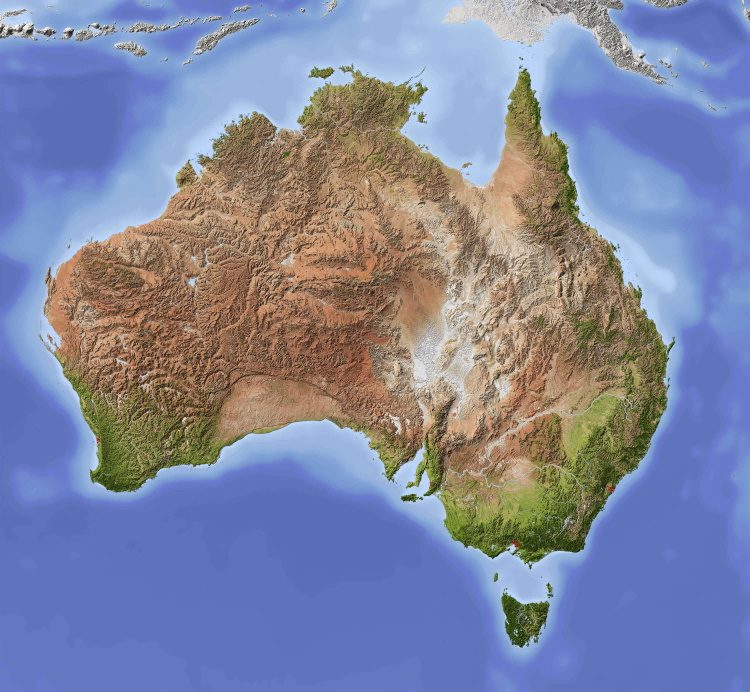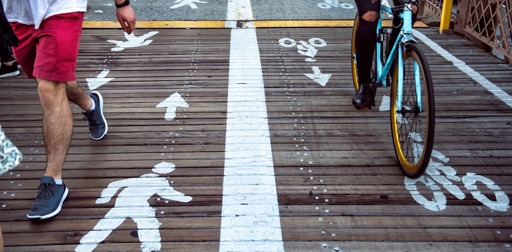Absolutely criminal numbers. Considering we know that cycling infrastructure has an RoI of at least 2, while roads have an RoI less than 1, the spending on cycling infrastructure should be much higher. I’ve seen 20% as the figure that should be spent, instead of the current 0.1%.
I remember seeing some numbers that every kilometre driven actually costs the EU money in terms of maintenance and the environment, whereas ever kilometre cycled was a net gain
Why are they focussing on federal funding only? I would expect federal funding to go largely to the sorts of roads which are important on a broad scale but less desirable for cycling or walking - freeways, highways, major arterial roads, and so forth. State and local government are the levels I would expect to find the majority of cycling and walking investment, it seems odd that these are omitted.
The Commonwealth funds all sorts of projects. They contributed, for example, to Brisbane City Council’s big Kangaroo Point green bridge. That bridge was one of the “five green bridges” that were a major campaign promise by the LNP in 2020. Unfortunately in part due to funding “issues” (read: prioritising roads for cars), that “five” has been watered down to “three”, two of which have been delivered as of today, and the third hasn’t even been up for community consultation on the design or alignment yet (it was, but even that process got stopped cold and will have to be restarted from scratch after the 2022 floods caused BCC to cut all cycling funding—but, again, not road funding).
BCC should fund more of this, as you say. But they don’t. And in the face of poor investment from Councils, it would be helpful if the Commonwealth were spending more than one measly dollar per person. That Commonwealth funding, even if the project itself was delivered by state and local governments, would make it easier to get more done. Maybe BCC wouldn’t have cut from 5 to (maybe) 3 if they knew the Commonwealth would significantly help fund them, rather than the current begging for scraps.
As another example, the Commonwealth famously spends a lot on “black spot” funding. They should make it a condition of receiving black spot funding that the intersection and its approaches are upgraded with best practice safe cycling infrastructure (along with a robust definition of “best practice” that takes cues from successful designs from overseas, rather than relying on the current clearly inadequate definitions Australian road engineers use). Instead, a lot of black spot “upgrades” end up making the roads they’re on more dangerous for cyclists.
My point was that if you’re writing an article talking about how much Australians spend on cycling/walking infrastructure you should at least mention that federal numbers are not the whole picture and that federal is not the level of government that is going to cover most of said infrastructure. Omitting this smacks of the author just looking for a low number to draw attention/outrage.
That’s sort of fair, but it’s the same argument people use to justify the Commonwealth spending more on private schools than public. “Oh, yeah they do, but the state governments spend more on public schools.” That may be true, but IMO every level of government should have budgets that stand up to scrutiny.
You’re right. About 1% of our transport infra spend goes to active transport. And it’s mostly from state and local governments. It’s still very low, but not as disproportionate as the article suggests.
I live 15km from work and public transport doesn’t put you anywhere near it and there are no convenient bicycle paths. One of the most direct routes requires crossing the same road like 3 times or sharing the road with a 70km speed limit.
It could be such an easy ride but the considerations have not been put in place to make cycling a serious option for people that live nearby
Yeah it really sucks.
And way too many people, in your situation, would come away saying cycling doesn’t work. Instead of blaming the bad planning. Which only increases the chance of bad planning in the future, because of a lack of support for better planning.
You’re right. You can’t have a hodgepodge of cycling infrastructure that doesn’t lead anywhere and blame people for not using it. Cycle paths need to have planning and purpose and then you’ll see some actual uptake
Bike manufacturers and footwear apparel companies don’t pay big enough bribes.
Let me tell you about big foot
That actually got a chuckle out of me x3
And how much of that “cycling infrastructure” mileage and spending is on easy yet expensive and useless examples such as along freeways, in islanded suburbs where calm backstreets should suffice, or just mystery unconnected segments?
Does anyone know of any studies on this?
I don’t think I’d call along freeways “useless”. Easy, yes, comparatively. But I’d say it’s incredibly useful as trunk infrastructure.
But you’re right, it’s much less useful when not part of a proper connected network. I don’t know of any studies into this, but that would be really interesting to see.
A couple of other things that frustrate me: when there is good trunk infrastructure, but it loses priority at intersections. I’m talking the North Brisbane Bikeway at Albion Rd & McDonald Rd/McDonald Rd & Blackmore St, where the Primary Cycle Route crosses a Neighbourhood Road, but the bikeway does not run continuously across that intersection. And on the Southwestern Freeway/Centenary Freeway bikeway when it crosses Witton Rd, where it has to give way to a small secondary road, and Fig Tree Pocket Rd, where it has to give way to both the on and off ramps of the highway, rather than going under or over the main road like the Gateway cycleway always does, or simply requiring cars to give way at a wombat crossing.
Trucks are heavy and make modern life possible. You need thick concrete and rebar and a subsurface and a lot more besides. Trucks also leave the populated areas and need a lot of miles of that heavy duty road.
A bicycle requires a dirt path. Maybe some asphalt if you’re feeling fancy. They barely leave the populated areas too. Few people cycle in the outback.
The budget makes sense. Australia isn’t exactly crowded like much of Europe, you can’t just copy their models and expect the same results.
Guessing you are not from Australia and have never been here. Thick concrete and rebar are not typically how we construct our roads. The vast majority use flexible pavement.
The budget makes sense
0.1% makes sense? Jesus that’s a dumb take.
Actually I decided to look it up. It’s about $2.5 million per mile for a basic 2-lane asphalt road. https://www.welovepaving.com/how-much-does-it-cost-to-pave-one-mile-of-road-in-california/#%3A~%3Atext=Paving+one+mile+of+a%2Ccosts+of+%24560%2C000+to+%241%2C050%2C000.
That number can get much higher very quickly if you use concrete, have more lanes, need bridges or tunnels, and whatever else comes up.
A mile of 4 ft wide concrete sidewalk is about $182,265.6
https://www.lawnstarter.com/blog/cost/concrete-sidewalk-price/
And very few are walking/bicycling from Perth to Brisbane, but there’s still trucks going in between which depend on the road network.
More money per mile and more miles means it costs more.
But what you’re neglecting there is the fact that our road network is already complete. Aside from new developments, all it needs is maintenance. Our bike network is woeful. There are almost no trips that can be taken entirely on separated bikeways. There are hundreds of kilometres of bikeways needed in Brisbane alone before we could be considered to have even a moderately successful bike network.
And, again, this is positive ROI.
Also: we have too much of a reliance on trucks as it is. Any inter-city road that gets more than half a dozen road trains per day should probably have actual trains to take that freight far more efficiently. Ditto roads seeing the equivalent of that in regular semis. But that’s a conversation for another thread.
Y’all apparently pave it with asphalt, which has sky high maintenance costs compared to concrete + rebar. That would be something I consider to be the actual issue, especially when you run super heavy truck trains like y’all do. If I was in charge of your road network, which I’m not, I’d start paving your big roads properly. But that’s neither here nor there.
Wait, where are you that they make roads out of concrete? I’ve never heard of such a thing.
Can be fairly sure they are in the USA.
To grossly simplify a very expansive topic of concrete vs asphalt, vs bitumen…
Concrete = more upfront cost, slower to built. It is more durable. Costs more to repair. Less traction. More noisy to drive on due to joints.
Bitumen = cheapest up front to build. Less durable, but can still get a fairly good life out of it if designed to meet expected loads. Can be repaired more cheaply.
Asphalt. Middle ground between the two. (It’s effectively bitumen with cement binder added) Most of our freeways, major arterial roads here are asphalt.
Things that effect the choice: Different CAPEX vs OPEX strategies, especially with politics for public roads.
Local availability of materials.
Local environmental conditions i.e. freeze / thaw cycles we don’t have to deal with in most of Australia. High temperatures we do get, which does effect bitumen.
Fair to say that costs in one country for different labour and materials look a bit different too.
Huh. I had no idea bitumen and asphalt were even different things.
We don’t do them anywhere near as much as America apparently does but since I believe you’re around Brisbane I can pretty much guarantee you’ve driven on concrete roads (it’d be a lot less likely if you lived in Woop Woop). Look for it on primary routes that get a lot of heavy vehicle traffic - for example head south on the Pacific Highway and you’ll find large sections of concrete.
Oh damn. I don’t go that way often (my whole life is northside or within one kilometre of the river on the southside), but I have been down there a few times. I don’t think I’ve ever actually noticed the road being concrete. That’s wild to me.
What are these miles and ft you speak of ?
Sorry, 1.69 (nice) Kilometers and .305 Meters, or roughly 1/2 of a Futball/Soccer Ball
Sorry we’re not big on soccer here. Got that in football lengths? (I’ll accept either Aussie Rules or rugby footballs.)
A foot is about two cm longer than a Rugby ball
How much do you think a road costs versus a bike path? If anything, bike paths are over funded.
Have you ever looked into what goes into a road? And what goes into a bike path/sidewalk?
Have you ever looked into what goes into a road? And what goes into a bike path/sidewalk?
Have you? I’ve seen wide ranging figures around the world, but Australian data says every dollar spent on bike paths returns $5 to the economy. Meanwhile, money spent on roads costs the economy, returning less than $1 per dollar spent.
Nobody is saying we shouldn’t have roads, but the amount spent on them is obscene, considering the opportunity cost.
It just reflect usefulness of each applications. You needs trucks but bicycle is just a hobby. Walking just do not need much infra at all.
Where do you get the ridiculous assertion that a bicycle is just a hobby? Plenty of people cycle to work, shops, visit friends etc. I am one of them.
Brisbane City Council openly publishes counts of cycle paths around Brisbane. There are literally thousands of people using these on weekdays to commute.
Bicycles are not essential. Get rid of bicycles and nothing will happen, get rid of the trucks and cars and everything stops. It is people choice to use them, not necessity. Which is a definition of a hobby.
Haha tell me, what car or trucks were used by the silk road traders to move people or cargo across continents? Did the Romans wait 2000 years for cars to be invented before they could use the roads the my built?
If you want a more modern example, cargo ebikes can carry a family and some can carry payloads up to 500kgs. Ever seen bike couriers, pizza deliveries on bikes? Trains are pretty good for freight too.
Your car brain is showing. Cars and trucks are a modern convenience, that is all. They are dangerous to humans, wildlife and the environment, but the only reason you think they are essential is because that’s what you grew up with and our infrastructure builders (govco) have prioritised them over other forms of transport - or more efficient forms of transport such as a bike. Fuel companies and car manufacturers do political donations…
If I want to go to a shop for a litre of milk, why do I need to lug a 1600kg lump of steel with me? Its inherently ridiculous to travel in this fashion for short to medium distances. Not suggesting we get rid of cars, but other forms of transport should be prioritised. You will never, ever solve congestion no matter how many lanes you add or roads you build. The only way is to reduce the amount of vehicular traffic using them.
And what about those who cannot drive, be it for age, medical reasons, lack of income to afford a car etc?
I can get everywhere by bike, train or bus. No need for a car. I have one, but by your reasoning, my car to me is just a hobby.
Roman example is just not applicable, we are in 21th century now.
“Cars and trucks are a modern convenience, that is all”. Do you really see that modern economy can function without cars and trucks? No, this is why we have to live with all their drawbacks,costs and dangers. There is simple no alternatives.
“I can get everywhere by bike, train or bus. No need for a car. I have one, but by your reasoning, my car to me is just a hobby.” And what made that possible, truck and cars. When you ride your bike to shop to buy a milk, how that milk get there ? By truck.
“And what about those who cannot drive, be it for age, medical reasons, lack of income to afford a car etc?” and what about those who can’t ride?
Roman example was to show the silliness of your argument, that the only way to get around or move things is by car or truck, when for millennia humans have used other forms of transport for the exact same purpose and effect.
Milk used to be delivered by horse and cart. Auspost now uses small epowered buggies for deliveries. Many countries use canal boats for deliveries. Humans adapt and always find solutions is the point, so no, things wouldn’t just stop.
Our society is built in recent times to prioritise motor vehicles, so that is what is currently in use, but it is unsustainable in the long run both socially and environmentally. There are better ways and other methods of transport that would be cheaper, greener and more efficient if we build infrastructure to support them. That’s what this thread is about, if you remember.
You also keep thinking we are advocating to get rid of cars and trucks, but nobody said that.
So you keep enjoying sitting in traffic congestion, thinking how wonderful it is to be in a car, and I will continue to ride in fresh air, sunshine with no traffic. I can see you aren’t interested in having an open mind to your thoughts, so I think we can agree to disagree and move on. Good luck.
“And what about those who cannot drive, be it for age, medical reasons, lack of income to afford a car etc?” and what about those who can’t ride?
What about them?
Spending 20% of the budget on active transport infrastructure would help those people, not hurt them.
You needs trucks but bicycle is just a hobby
bullshit
reality.
You’re delusional mate.
Any arguments? Discussion needs some, otherwise it just tossing shit to each other. Completely pointless, and harms both sides. Bicycles as mode of transportation is relic of the past now. We are not in Vietnam. Public transit, cars and trucks is what move this country.
All the data shows that the number one indicator of cycling rates is the quality of infrastructure. You’re begging the question by saying “we shouldn’t spend money on cycling infrastructure because nobody rides”.







